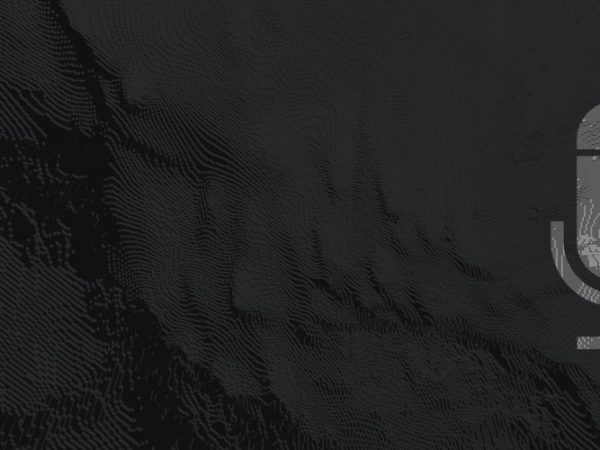Using a facecam is a great way to connect with your audience while streaming, but a poor quality camera can just as easily tank that connection. Unfortunately, most webcams on the market don’t offer the clean, high-resolution images you would expect from a professional stream. This is where DSLR cameras come in.
Your dreams aren’t dashed, but you need to think out of the box.
DSLR cameras, traditionally used for professional photography, have everything you need and more to boost your image. While mirrorless cameras are also an option, DSLRs boast better battery life, a longer history of developments, and plenty of options.
Before we dig deep into 5 of the best DSLR cameras on the market for streamers, let’s look at our best budget and our most advanced choices.
Best Budget
Canon EOS Rebel T7
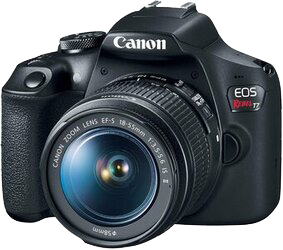
The Canon EOS Rebel T7 keeps costs low and serves as a quality DSLR camera without the premium DSLR price. If the idea of a four-digit price tag makes you sweat, you can’t go wrong with this choice.
Canon’s EOS Rebel T7 makes sure all your bases are covered. You get higher resolution, better video quality, adequate fps, and a variety of upgrade options. This DSLR is also a great choice if you want something to serve as an all-around camera that you can use beyond your stream setup.
Best 4K
Canon EOS 90D

Tapping into 4K resolution is a great way to set yourself apart from other streamers and future-proof your set up (at least for a while). While 1080p high definition is accepted as the norm right now, the Canon EOS 90D proves how much of an edge 4K has.
While you need to have a clear understanding of what you’re getting into, this is easily the most advanced DSLR camera on the list.
Top 5 DSLRs for Streaming
Whether you want to upgrade the quality of your stream without breaking the bank or you want to go all out, we have a solution.
*Note that these are stricly DSLR cameras. We have a separate guide on the best mirrorless cameras for streaming here.
Here are 5 of the best DSLR cameras for streaming:
1. Best Bang for Your Buck: Nikon D5600 DX Format
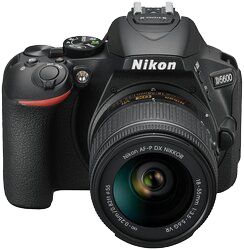
If you’re looking for a DSLR option that won’t skimp on features while also giving you the full experience, the Nikon D5600 has you covered.
While it’s not the cheapest DSLR out there, you get a wider variety of options and a great baseline for video quality.
The Nikon D5600 features 1080p video resolution at 60 fps, making it a great choice for vlogging on the go as well as streaming. While it isn’t 4K, the quality is still better than what you may get with other cameras.
You will need to purchase a capture card and an adapter cable to use the Nikon D5600, but this is a quick and easy work around for higher video quality and a more professional stream.
| Image Sensor Resolution | 24.2 megapixels |
| Video Resolution | 1080p (HD) |
| Frames per Second | 60 fps |
| Sensor Type | CMOS (APS-C) |
| Wireless Connectivity | Wi-Fi, Bluetooth, NFC |
| HMDI | Mini |
| Weight | 1.60 lbs |
| More Specs & Reviews | Read more |
Pros
- Easy to connect for streaming
- 60 fps for streaming
- Easy to use and great for starting
Cons
- Need adapter to connect
- Limited wi-fi connectivity
2. Budget 4K: Panasonic LUMIX FZ300
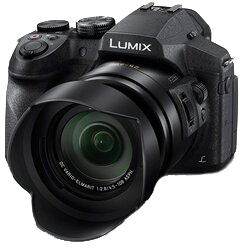 The Panasonic LUMIX FZ300 is not only a great budget option for 4K, but it sits on the lower price range of DSLR overall. This means that you can not only get a DSLR camera for a lower cost, but you can unlock the benefits of 4K Ultra High Definition video.
The Panasonic LUMIX FZ300 is not only a great budget option for 4K, but it sits on the lower price range of DSLR overall. This means that you can not only get a DSLR camera for a lower cost, but you can unlock the benefits of 4K Ultra High Definition video.
Whether you just want to test out 4K or want good image quality without sacrificing battery life, the LUMIX FZ300 is a good choice. The camera can easily serve you for years, both in and out of streaming.
While the image quality goes beyond a regular web camera, we can’t ignore a few things.
The LUMIX FZ300 uses a smaller sensor, so it may not work as well in low light and you’ll notice a lower dynamic range. It’s also a bit heavier than the other cameras on this list, so it’s not the best option if you want to take it along and capture content throughout your day.
| Image Sensor Resolution | 12.1 megapixels |
| Video Resolution | 2160p (4K) |
| Frames per Second | 60 fps (4K); 30 fps (HD) |
| Sensor Type | BSI-CMOS |
| Wireless Connectivity | Wi-Fi |
| HMDI | Micro |
| Weight | 1.52 lbs |
| More Specs & Reviews | Read more |
Pros
- Rugged design
- 4K video resolution
- Decent battery life
Cons
- Low image resolution compared to competition
- No clean out
3. Best for Under $500: Canon EOS Rebel T7
 The Canon EOS Rebel T7 proves that you don’t need to dish out thousands of dollars for high quality results. When the financial hurdle for using a DSLR camera is lower it’s much easier to make the move to switch.
The Canon EOS Rebel T7 proves that you don’t need to dish out thousands of dollars for high quality results. When the financial hurdle for using a DSLR camera is lower it’s much easier to make the move to switch.
Even if you’re using the camera to test the waters of DSLRs, the Rebel T7 won’t disappoint. While it doesn’t offer 4K resolution, 24.1 Megapixels and high definition video are all that you need.
The Rebel T7 is lightweight and easy to carry around, but it’s also incredibly easy to set and forget on a desk. Canon’s EOS Utility Webcam software makes it easy to use many of their DSLR cameras as a plug and play webcam.
Because the Rebel T7 was grandfathered in, you will need to purchase an adapter USB cable, but this is a small price to pay for clean output (and you have plenty to spare thanks to the budget price).
The one area where the Rebel T7 could improve regards battery life. The LP-E10 batteries don’t last as long as some of the competition, so you may run into issues with longer streaming sessions.
| Image Sensor Resolution | 24.1 megapixels |
| Video Resolution | 1080p (HD) |
| Frames per Second | 30 fps |
| Sensor Type | CMOS (APS-H) |
| Wireless Connectivity | Wi-Fi, NFC |
| HMDI | Mini |
| Weight | 1.04 lbs |
| More Specs & Reviews | Read more |
Pros
- Well-loved APS-H CMOS sensor
- High definition video resolution
- Lightweight
- EOS Utility Webcam compatible
Cons
- Low battery life
- Lower frame rate
- Need to purchase USB for EOS Utility Webcam separately
4. Best 4K: Canon EOS 90D
 While the price may seem a bit flashy, the Canon EOS 90D is a clear example of what you want from a 4K camera.
While the price may seem a bit flashy, the Canon EOS 90D is a clear example of what you want from a 4K camera.
The EOS 90D still goes above and beyond. With an image resolution of 32.5 megapixels, your viewers will be able to see you so clearly they can almost read your mind.
The EOS 90D also features an option for 120 fps with high definition video. While you’re still limited to 30 fps for UHD, this provides an edge over most 1080p competitors.
The extra capabilities of the EOS 90D don’t add to its weight, but you should have some DSLR experience before trying to set this camera up. Unlike simpler designs, this 4K option may be too complicated for those who don’t know what they are getting into.
| Image Sensor Resolution | 32.5 megapixels |
| Video Resolution | 2160p (4K) |
| Frames per Second | 30 fps (4K); 60/120 fps (HD) |
| Sensor Type | CMOS (APS-C) |
| Wireless Connectivity | Wi-Fi, Bluetooth |
| HMDI | Mini |
| Weight | 1.32 lbs |
| More Specs & Reviews | Read more |
Pros
- High image and video resolution
- Fast frame rate
- EOS Utility Webcam compatible
- Quiet autofocus
Cons
- Not a great choice for those new to DSLR
- Need to purchase USB for EOS Utility Webcam separately
5. Full Frame: Canon EOS 6D Mark II
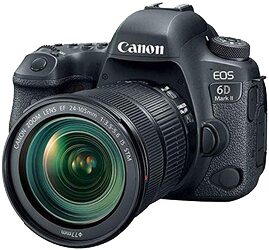 Not everyone wants a full frame camera for streaming, but for those that do the EOS 6D Mark II from Canon is the best choice.
Not everyone wants a full frame camera for streaming, but for those that do the EOS 6D Mark II from Canon is the best choice.
The sensor is the same size as that of an analog camera, meaning there is no crop factor that cuts off part of your image. This allows pixels to spread out over a larger surface and capture more light, so you can capture clearer and sharper images.
This camera has a 45 point autofocus system, so once you find your target you can ensure it stays in focus. The built in Wifi, NFC, Bluetooth, and GPS connectivity also ensures you can sync up to almost anything you want.
You will need to purchase a Mini HDMI to USB adapter to use the Utility Webcam software, and you should understand that your streaming lens options are limited due to the full frame sensor. This shouldn’t be an issue for streaming, but it limits what you can use the EOS 6D Mark II for.
| Image Sensor Resolution | 26.2 megapixels |
| Video Resolution | 1080p (HD) |
| Frames per Second | 60 fps |
| Sensor Type | Full-frame CMOS (35mm) |
| Wireless Connectivity | Wi-Fi, NFC, Bluetooth, GPS |
| HMDI | Mini |
| Weight | 1.69 lbs |
| More Specs & Reviews | Read more |
Pros
- EOS Utility Webcam compatible
- Full frame sensor
- Touchscreen control
Cons
- Need to purchase USB for EOS Utility Webcam separately
- Small autofocus coverage
- Limited lens compatibility
Things to Consider When Buying a DSLR for Streaming
When you’re making a purchase as big as this one for your stream setup, you should have a clear understanding of what you need. Not every DSLR is worth your time, and there are plenty of options that flat out won’t work for streaming.
Focus on cameras that offer:
- High resolution and frame rate
- Compatibility with your streaming set up (or an easy work around)
- The ability to turn off energy saving features like “auto power off”
These are the biggest hurdles to clear when using a DSLR for streaming.
Video Quality: Resolution & Frame Rate
The most obvious details you want to consider when looking for a DSLR for streaming affect video quality. If you want to skip the details, just understand that cameras with higher resolution and higher frame rate generally have better video quality.
Your DSLR camera has 2 resolutions to pay attention to.
The image sensor resolution refers to still image resolution, pretty much only in the form of megapixels. You’ll see more difference in the image resolution of two similar cameras.
The other refers to video output resolution. When it comes to streaming you want a minimum of 1080p (high definition), but recent technology has made 2160p (4K or ultra high definition) more accessible. It still costs quite a bit, but it’s the next step in video quality.
The last detail to pay attention to is the frame rate of the camera. You probably already understand that a higher frame helps with fast action, but you don’t need the highest frame rate to capture your profile while streaming video games.
If you just plan on using your DSLR camera to provide a high-quality replacement for a streaming webcam, 30 FPS works perfectly fine. If you need a camera that can multi-task and capture quick action, look for one with 60 FPS.
Streaming Compatibility
Another detail to pay attention to is how the camera connects to your computer. This is one of the few cases when you have little to no wiggle room for wireless connectivity, at least while you’re streaming.
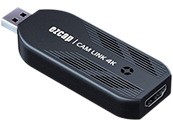 Most DSLR cameras connect using an HDMI cord, but many computers only feature an HDMI out port. This means that you need to use a HDMI to USB video capture device like the Elgato Cam Link 4K to use your DSLR as a web camera for streaming.
Most DSLR cameras connect using an HDMI cord, but many computers only feature an HDMI out port. This means that you need to use a HDMI to USB video capture device like the Elgato Cam Link 4K to use your DSLR as a web camera for streaming.
You should also identify the specific type of HDMI cord you need for your DSLR camera: micro, mini, or full size. This affects the type of HDMI adapter you need to purchase for your capture card.
Auto Power Off Options
Something to pay attention to when using your DSLR camera for streaming is the automatic shutdown feature. These cameras weren’t designed for prolonged use, and they usually have an auto power off preset designed to conserve battery life.
One of the first things you want to do when you set up your camera is find this feature (sometimes referred to as an “energy saving timer” and turn it off. If you can’t disable it, make sure you set it to the longest setting possible (usually 30 minutes).
If you want to use the LCD screen to make sure you don’t look like a fool while streaming, make sure you disable or adjust the LCD auto-off timer as well.
While you’ll need to learn to fiddle with your camera to keep it awake, it’s a price well paid for higher video quality.
FAQs
Can I Use a DSLR for Streaming?
You can use a DSLR for streaming using the tips mentioned above for clean connection and optimal settings. While DSLR cameras were not designed for prolonged web camera use, there are several workarounds that make the higher video quality easily accessible.
Why Do Streamers Use a DSLR?
Streamers use a DSLR camera for streaming because it provides a high-quality finish to their streams. These cameras have better sensors and better customization that make them an effective investment for a streaming setup. While a normal webcam may be cheaper, a DSLR camera showcases professionalism.
Final Thoughts
You really can’t go wrong with any of the DSLR cameras on this list, but we can’t recommend the Canon EOS Rebel T7 enough.
This is a competitive choice when you’re deciding between a pricier webcam and an entry-level DSLR, and the Rebel T7 proves that you don’t need to cost more than gold to make a major impact.
Not only is it easy to use as is, but the availability of Canon’s EOS Utility Webcam software makes setup a breeze compared to other brands.
As long as you can stomach the upfront cost of improving your stream quality, you won’t regret switching to a DSLR.
WINNER


